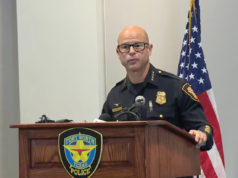Notice the change in this week’s paper?
It’s shorter by an inch. Newspapers across the country are getting smaller – The New York Times, USA Today, Fort Worth Star-Telegram, The Dallas Morning News, etc.
Think about it: Cut down on paper size and edge up the type size, and you can print fewer and smaller stories than before, saving money on paper, ink, and reporters’ salaries. Readers get screwed – they’re paying more for less – but in these days of corporate journalism, readers don’t matter as much as that ultimate tyrant, the bottom line. Newspaper execs usually claim they make these changes as a reaction to focus groups and reader surveys. Boo-corn. It’s to save money.
In Fort Worth Weekly’s case, the page size is getting smaller because we are printed by a local commercial printer that prints daily newspapers such as USA Today. Generally, we all use the same size paper, so if they get smaller, we get smaller unless we want a custom (and more expensive) print job.
Static wishes it could say that the stories won’t be any shorter, but the physical reality is, yep, we will lose a little space – a smaller news-hole, as journalists say. (No comments, please.) The stories might look a little clunky and oddly spaced for a week or two as the design staff adapts to new computers and software as well as our new page size. What won’t change is the edit staff’s desire to write in-depth, interesting, and uncensored stories. As they say, it’s not “all the news that’s fit to print,” but “all the news that prints to fi
Whale-Spot(light)ing
“You can change even the leviathan of the federal government,” said Tom Blanton, “by shining a light.” Blanton should know. His nongovernmental group with a government-sounding name – the National Security Archive based at George Washington University in D.C. – has been in the flashlight business for years, making public all kinds of data that the government would just as soon no one knew existed – from the “crown jewels” of the CIA, exposing decades of the agency’s illegal activities, to White House out-take photos showing Nixon and Elvis comparing cufflinks.
If you think digging through boxes of old, dusty documents written in bureaucratese sounds boring … well, you didn’t have Blanton as a tour guide, like the 130 or so people gathered in an Arlington’s Cacharel restaurant a few evenings ago did.
Blanton spoke at the local Society of Professional Journalists awards banquet (story, page 8), and parts of his talk were scarier than recent local weather.
Records revealed under the federal Freedom of Information Act, he said, “have changed the course of human behavior.” Like revelations about the poor quality of body armor being issued to U.S. troops, or the amount of mercury routinely being found in tuna. Public information requests filed by journalists and researchers aren’t the only methods for getting light into the government’s dark corners, of course.
There are the ranks of corporate and government whistleblowers – and people like Diane Wilson. She’s the activist, author, and former shrimp-boat owner who, after finding out that the Texas bay where she made her living was being systematically polluted with a toxic soup of industrial byproducts – and unable to get the government to do anything about it – went on a series of hunger strikes and eventually sank her boat over the pollution discharge location, to make her point. “The only way to get the information out was the media,” she said. “You cannot believe how important it was for us to reach people like you.”
The chicken dinner was nice. But Blanton and Wilson were worth far more than the price of admission.










